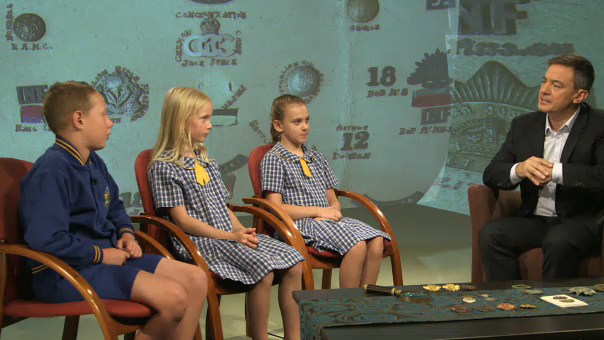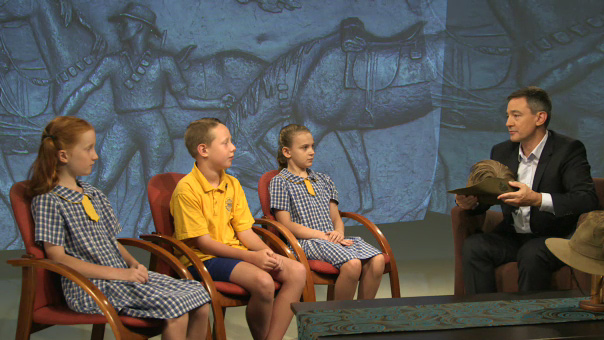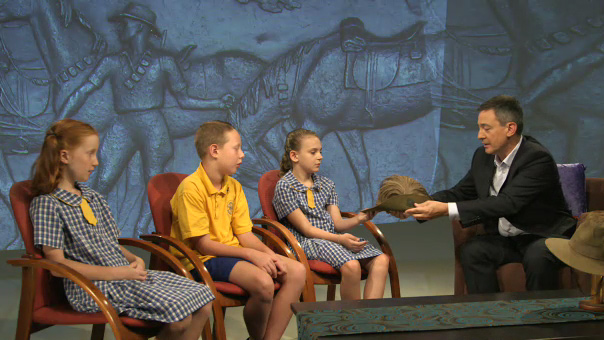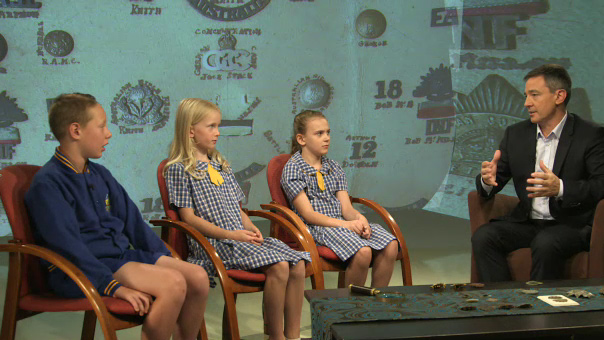Viewing guide
Use a digital collaborative tool to create a class list of things that symbolise Australia.
Discuss why the items were included.
Look at the Australian Coat of Arms, the Australian Flag and the Australian Aboriginal Flag. Which things on the list appear on the Coat of Arms or the flags?
Which elements of the Rising Sun badges represent Australia?
How do the Rising Sun badges suggest Australia’s connection to Britain?
What features on the badges help us to date them?
What does the sun rising in the sky each day mean to you?
Look at Rising Sun badges from the past and also the current badge. Discuss:
-
what you can see on all of the badges
-
what changes have occurred over time and why
-
what the sun represents on the badge
-
why the sun is an important symbol on the badge.
Anzac stories is a suite of videos relating to aspects of the First World War. Rising Sun—part
1 is a Stage 2 history resource that focuses on Anzac symbols and commemoration.
In this video the senior historian from the ANZAC Memorial displays historical artefacts, Rising Sun badges, to a group of students and discusses their symbolism. Rising Sun—part 2 follows on from this video providing more information about the symbolism of the Rising Sun badge.
This video resource addresses the following NSW Board of Studies, Teaching & Educational Standards, history Stage 2 syllabus outcomes.
A student:
-
identifies celebrations and commemorations of significance in Australia and the world (HT2-1)
-
applies skills of historical inquiry and communication
Days and weeks celebrated or commemorated in Australia (including Australia Day, ANZAC Day, Harmony Week, National Reconciliation Week, NAIDOC Week, National Sorry Day) and the importance of symbols and emblems (ACHHK063)
Students:
-
identify and describe local, state and national symbols and discuss the origins, symbolism and significance, eg the school logo, Australian and Aboriginal and Torres Strait Islander flags, coats of arms from states and Australia
-
identify important Australian celebrations and commemorations and discuss their origins and significance in society.
Brad Manera: The rising sun is a symbol used on the badge of the Australian Army. But badges and symbols are used everywhere. Cooper, you're wearing a badge and symbols. It's your school badge. Tell us about it.
Cooper: It's my school emblem. It has a historic building and a rose garden.
Brad Manera: OK. How does that make you feel?
Cooper: It makes me feel part of my school.
Brad Manera: Exactly. And that is the unifying power of badges and symbols. So, you know, where this badge makes Australian soldiers feel part of an army, your school emblem makes you feel part of that school. Over 100 years ago, when Australia was made up of a group of British colonies that didn't necessarily get on well together, each one used their own symbol, particularly amongst their military, the badge of their colony. I'll show you two of them. For example, this is the badge worn in New South Wales in the 1890s. It's got a lion inside a Southern Cross in a wreath of waratah—the symbol of New South Wales. This is the badge worn by the defence force from my home state in Western Australia. In the middle is a black swan— very, very strong symbol of Western Australia. In 1901, all of those colonial defence forces were combined and it was the start of the Australian Army. They couldn't wear these old badges. They needed a new symbol. They needed a new symbol and they needed it very quickly because we were at war. Australia was sending soldiers. Each of the colonies were sending soldiers to a war that the British Empire was fighting in South Africa, and so we needed a symbol that would unify all of those soldiers leaving for the war in South Africa against the Boers. And they came up with a symbol that has become famous. It's called the Rising Sun. The Australian General Service badge has been known as the Rising Sun. This was the first Rising Sun designed and it came out in time for those soldiers to go to South Africa in 1902. And if you have a look at it, you can see the term 'Australia' above a crown, all framed in the rays of a rising sun. How about we pass it around? Can you see the rays of the sun? And the crown worn by the ruling monarch at the time? Australia was part of the British Empire and so we used the symbol of the monarch—the crown. Fourteen years later, we were involved in a much bigger war. Our soldiers were part of a much more complicated army. And so, they needed a slightly different badge. They wanted to convey this idea of a strong military force. They came up with a badge that was a variation on the Rising Sun. In fact, let's have a look at the way that Rising Sun badge has changed. They're three Rising Sun badges, but each one of them is different. Each one of them dates from a different time period. Now, yours is the oldest. Can you describe it to us?
Isabella : Um, well, my scroll says the ‘Australian Commonwealth Military Forces’. It's also got a king's crown and it's made with bronze.
Brad Manera: Well done. How...now, if you have a closer look, can you describe that crown? You've already told us it's a king's crown. That's because we were talking about that earlier. How does the king's crown differ from the queen's crown?
Isabella: Well, a queen's crown has, um, like... it has those bumpy parts which comes up with, like, a point on the top.
Brad Manera: OK. That's a good description. If we look at that really old badge...when this badge came out, Queen Victoria was on the throne. And you can see from her crown, it's...as you say, it's got bumpy bits on the side. It flares out at the side. A king's crown goes almost straight up, so when we take a closer look at your badge, it doesn't flare out like the queen's crown. That's how we can date them, because we didn't have a king and a queen on the throne at the same time. What I'd like each of you to do is read the scroll on the badge in front of you.
Isabella: Australian Commonwealth Military Forces.
Brad Manera: OK, Lily, what's on yours?
Lily: Australian Military Forces.
Cooper: Australian Military Forces, and on the back, Stokes.
Brad Manera: Stokes was the person who made it, and they had a factory down in Melbourne. Now have a look at the shape of the crown. Cooper, what does your crown look like?
Cooper: Straight up.
Brad Manera: Straight up. So that tells us it's a king's crown. What does yours look like, Lily?
Lily: A queen's crown.
Brad Manera: A queen's crown.
Isabella: And mine goes straight up.
Brad Manera: And yours goes straight up. Two king's crowns, one's a queen's crown. Two scrolls are the same. One scroll's different. So what we've got are three badges from three different times and we're able to date them by the symbols that are used on that badge.
Before student viewing
Before students view the video discuss their school badge or another badge or emblem that includes symbols. Talk about why these symbols were chosen to represent their school or other organisation.
Set up an online collaborative tool such as a Google Doc, Office 365 Word doc, a lino canvas or another collaborative tool where students can add their ideas about symbols that could represent Australia.
Introduce students to Australian national symbols such as the Australian Coat of Arms, the Australian Flag and/or the Australian Aboriginal Flag. Students identify symbols from their list that are incorporated into these.
Point out the Southern cross on both the Australian flag and the Australian Coat of Arms.
Ask students to research one or all three of the national symbols and identify their:
-
origins
-
symbolism and meaning
-
significance.
During student viewing
Ask students to watch the video and then discuss:
-
Which elements of the Rising Sun badges represent Australia?
-
How do the Rising Sun badges suggest Australia’s connection to Britain?
-
What elements on the badges help us to date them?
Replay the video if required.
After student viewing
Draw students’ attention to Rising Sun badges from the past and also to the current badge. Talk with students about:
-
how the badges have changed over time and why these changes might have occurred
-
what elements feature on all the badges and why this might be
-
why the sun is an important symbol on the badges.
Resources to support learning activities in Rising Sun badge—part 1.
Although this resource is copyright NSW Department of Education, we would like to acknowledge the sources for images.



